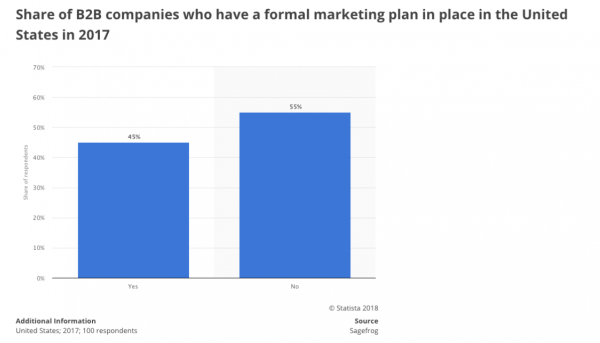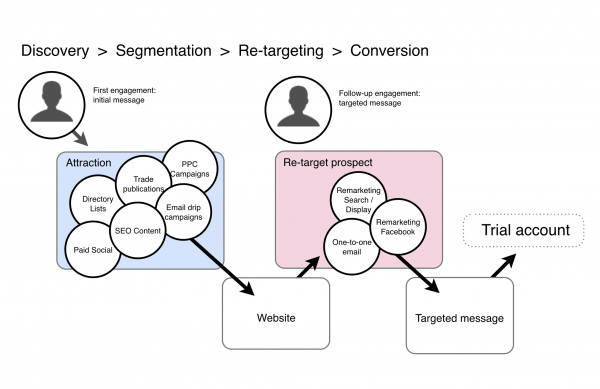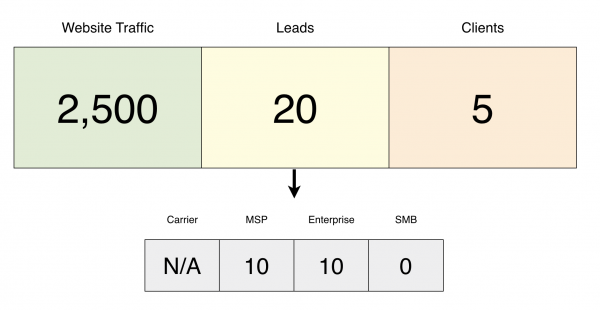
A B2B marketing plan should help teams stay on track, achieve goals, and focus on the right objectives. Though having a marketing plan may seem obvious before starting a campaign, the majority of B2B companies do not have one.

55% of B2B companies do not have a formal marketing plan in place (Sagefrog/Statistica). Organizing a B2B marketing plan does take time and effort, but it is well worth it. For those ready to begin the process, here are components to include and things to keep in mind.
So why even create a plan? A marketing plan gives everyone -- not just marketers -- a strategic direction which fosters alignment, support, stakeholder buy-in, and trust. For new members of a marketing team, it makes onboarding simple and straightforward. For non-marketers, a marketing plan gives understanding as to why certain actions are taken.
A B2B marketing plan defines the marketing focus and goals, putting everyone, company-wide, on the same page. This will create alignment between the marketing team and those supporting marketing efforts, such as sales and data teams.
Once the team creates a marketing plan, it must be able to change. Marketing plans need to be adaptive because no one can predict every twist and turn in the road. Trying to plan every campaign, topic, and focal point can be a fool's errand. Your plan provides broad guidance but should not remove adaptation, testing, and iteration at a campaign level.
B2B marketing plans should be created to allow for change since, in the world of marketing, change is inevitable.

The elements of the plan should start with understanding the buyer. Since the B2B marketing campaign will center around the buyer, the plan should include plenty of information about the prospect as well. Information such as the buyer’s aspirations, pain points, role, and how they buy are all musts to include in the plan. This information will guide campaigns forward.
A marketing plan should also include a messaging strategy. Ultimately, marketing will control the perception of the buyer and alter their behavior accordingly, and this is all done through strategic messaging. Therefore, marketers need to communicate value to the consumer by describing a solution to their problem or challenge. This is strategic messaging, and companies should strive to keep it consistent and simple. It will take time to narrow down clear messaging, but teams should make sure this is laid out in the marketing plan.
Goal setting is also part of the marketing plan. While individual goals per campaign do not need to be included, measurement tactics do. Goals should center around increasing the lead pool or increasing the amount of marketing-qualified leads (MQLs), increasing conversions in the funnel, increasing sales-qualified leads (SQLs), and increasing the number of clients or sales. How much of your plan should focus on lead generation and how much should focus on lead nurturing to the sales handoff, for instance?

Responsibilities and focal points are part of the marketing plan as well. It’s important to know who does what so tasks are split according to expertise and there is no unnecessarily overlap. An approval process can also go into the marketing plan, so any newcomer understands who needs to see what content before it goes live.
The marketing budget is organized in the marketing plan, broken down by marketing tactics (paid tools, social budget, etc.). Teams can organize the budget quarterly or monthly to understand how to make it last through the year.
Lastly, and an often forgotten piece of a B2B marketing plan, there must be a process for marketing to sales handoff. Often, sales teams do not follow up on marketing leads, which means potential sales get stuck in the pipeline. However, sales and marketing teams that work together are much more successful. A connected marketing and sales funnel enabled by marketing automation drive a 14.5% increase in sales productivity (Nucleus Research).

A process for how marketers give leads to the sales team, how to share learnings, and create a mutually supportive process rather than negatively-charged finger pointing must go in the marketing plan. Ideally, include a lead management process, lifecycle definitions, and a documented sales pipeline with stages.
Remember, the plan must be adaptive. Teams must also have a process for iteration, learning, testing, and optimization. There are plenty of reasons why marketing plans fail, so be sure to read our blog to avoid those pitfalls.
Companies with a clear B2B marketing campaign set themselves up for success. Strategic goals, clear roles, and dynamic, adaptive processes make a strong plan that companies should take the time to create.
Sources
Sagefrog, Share of B2B companies who have a formal marketing plan in place in the United States in 2017, 2017.
Nucleus Research, MARKETING DRIVES CRM ROI, April 2012.
by Jonathan Franchell, CEO of Ironpaper - For more tips and hacks: Need to remove a new line after h1 tags? Both web designers and SEO practitioners need to employ headline tags: H1, H2, H3 in several ways to improve web page structure and tag...

The marketing industry is transforming significantly due to generative AI and increasing market complexity. Gartner's prediction of a 25% decline in traditional search traffic suggests that the era of search engines is dying. AI tools, particularly...

The Crowded Arena of the IT Marketplace Updated December 2024 The Information Technology (IT) landscape is experiencing rapid growth and intensifying competition. IT spending is projected to reach nearly 5.1 trillion U.S. dollars in 2024, a...

Updated December, 2024 The field of digital marketing is evolving rapidly in response to new technology and changing buyer expectations. To help career-minded marketers, we’ve rounded up the top 10 skills needed to succeed in the field. These are...
